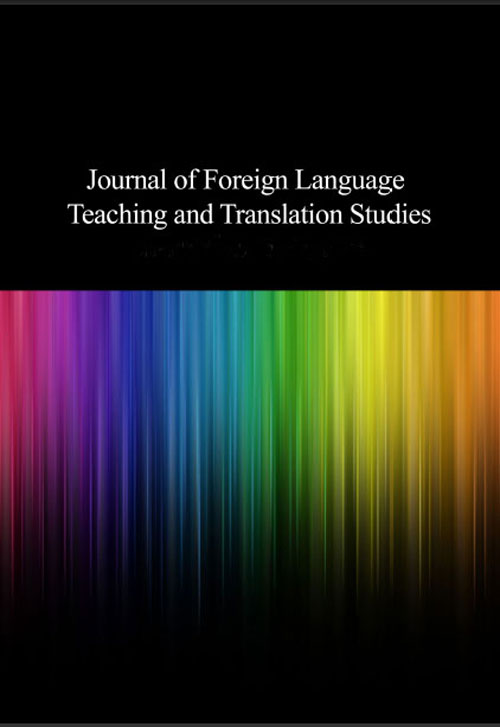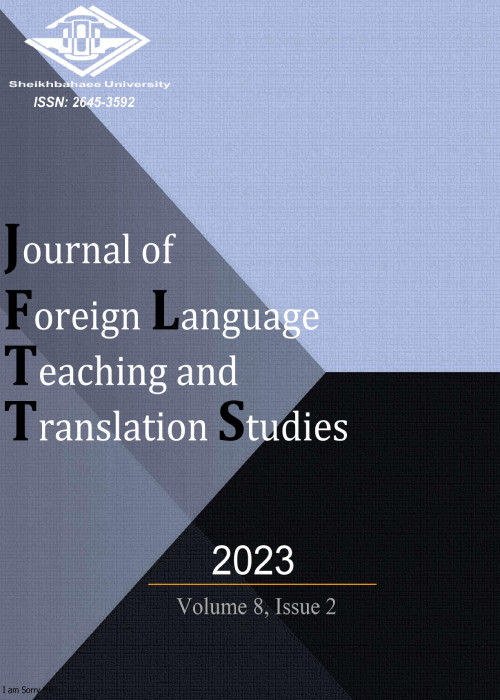فهرست مطالب

Journal of Foreign Language Teaching and Translation Studies
Volume:1 Issue: 2, Summer 2012
- تاریخ انتشار: 1396/09/30
- تعداد عناوین: 6
-
Page 1Computer technology has provided language testers with opportunity to develop computerized versions of traditional paper-based language tests. New generation of TOEFL and Cambridge IELTS, BULATS, KET, PET are good examples of computer-based language tests. Since this new method of testing introduces new factors into the realm of language assessment (e.g., modes of test delivery, familiarity with computer, etc.), the question may be whether the two modes of computer- and paper-based tests comparably measure the same construct, and hence, the scores obtained from the two modes can be used interchangeably. Accordingly, the present study aimed to investigate the comparability of the paper- and computer-based versions of a writing test. The data for this study were collected from administering the writing section of a Cambridge Preliminary English Test (PET) to eighty Iranian intermediate EFL learners through the two modes of computer- and paper-based testing. Besides, a computer familiarity questionnaire was used to divide participants into two groups of high and low computer familiarity. The results of the independent samples t-test revealed that there was no statistically significant difference between the learner's computer- and paper-based writing scores. The results of the paired samples t-test showed no statistically significant difference between high- and low-computer-familiar groups on computer-based writing. The researchers concluded that the two modes comparably measured the same construct.Keywords: comparability study, Computer-based Language Test (CBLT), Paper-based Language Test (PBLT)
-
Page 2There is a general consensus that critical thinking can be influential in almost every occupation due to its association with the abilities such as problem solving and decision making. This paper aims at probing the role of critical thinking (CT) skills on EFL learner's reading comprehension performance using Bloom's taxonomy. Therefore, the role of CT strategies training across two language proficiency levels, high & low, was investigated. Then the difference between females and males regarding their CT was studied. In so doing, 240 male and female Iranian EFL students were selected and screened into two proficiency levels based on the Longman preparation course for TOEFL test. Each proficiency group was divided into critical and non-critical group. The results suggested CT skills significantly affected EFL learners reading comprehension performance. However, the effect of critical thinking strategy training didnt vary across different language proficiency levels. Overall, the findings provide empirical support for the facilitative effect of critical thinking strategy training on reading comprehension performance of EFL learners.Keywords: critical thinking, strategies training, gender, reading comprehension, language proficiency
-
Page 3This study was particularly concentrating on TOEFL type (CBT vs. P&P) and computer anxiety as independent variables, and test taker's performance as the dependent variable. The two TOEFL types (Paper-and-Pencil and Computer-Based) were given to 40 participants using counter balancing. The interval between the two tests was two weeks. The reason behind choosing this interval and counter balancing was to prevent the practice effect. Three days after the test, the computer anxiety questionnaire was also taken by the same participants. The results showed a high correlation between the scores on the two versions of the test (P&P vs. CBT), also there was no significant difference between the performances of t, and finally, there was no significant interaction between test type (P & high-, low-, and mid-anxious candidates on the two versions of the tesP vs. CBT) and computer anxiety level (high-anxious, low-anxious, and mid-anxious).Keywords: advanced EFL learners, P, P (Paper-and-Pencil test), CBT (Computer-Based Test), computer anxiety, computer anxiety scale
-
Page 4Despite its sociopolitical basis, Academic Literacy (AL) is recently referred to as a set of complex skills such as writing, which lays undeniable foundations for success in academic communities (Hyland & Lyons, 2002). This study is aimed at improving student's AL in general and their writing skill in particular at Khaje Nasiredin Toosi (KNT) University of Science and Technology. Based on the domain of EAP (Flowerdew & Peacock, 2001; Jordan, 1997), and among various academic assignments (Braine, 1995; Canseco & Byrd, 1989), student's summary writings at KNT University were selected to be investigated. Besides the summaries, 20 students were interviewed to delve more into the problematic areas. Data analysis of 1270 written errors indicated that sequence of tense, article use, and appropriate selection of words are the most prevalent error types. Further analysis of the data revealed that students had failed to develop their ideas properly in unified paragraphs. Moreover, students were unsuccessful to put their ideas in the simple format of introduction, body, and conclusion. The paragraphs also lacked cohesive ties. The article, accordingly, ends with some practical recommendations addressing the present issues.Keywords: EAP, academic literacy, error gravity, writing
-
Page 5The purpose of the study reported in this article was to explore images and metaphors English learners have in mind for vocabulary learning. First, 350 learners in seven cities in Iran with considerable experience of English learning were asked to compare vocabulary learning to concrete objects and activities. Their 130 analogies were reviewed and analyzed multiple times to identify fitting labels and assign inclusive categories. The five most frequent themes which emerged from the analysis were FOOD & DRINK, COLLECTING, JOURNEY, PUZZLE/PROBLEM, and MUSIC. Based on a scrutiny of the metaphorical themes and the images which gave rise to them, some salient practical and theoretical points with implications for teaching language and vocabulary are tentatively discussed.Keywords: English vocabulary, metaphor for vocabulary learning, mental image for vocabulary learning
-
Page 6The increasing use of technology in different parts of the world has inevitably led to the borrowing of a sizeable number of English words by many languages, including Farsi. This study was carried out with the aim of determining the extent to which a group of undergraduate Iranian EFL students studying at Sheikhbahaee University could accurately pronounce ten commonly-used technology-associated loan words with regard to two criteria: the placement of word stress and the pronunciation of words‟ sounds. To this end, 50 students were randomly drawn from among the foregoing university‟s students. Each student was given the chance to pronounce each of the ten loan words in and out of context. The students‟ oral performance was recorded and then was subjected to quantitative and qualitative analysis . The quantitative analysis revealed that the errors‟ frequencies were relatively high with respect to most words and very high with regard to two words. The qualitative analysis, which was done utilizing the literature of contrastive phonetics and pronunciation systems of Farsi and English, helped partly explaining many of the students‟ errors and highlighting the need for the devotion of more pedagogical and research attention to the problems confronting Farsi-speakers in the area of the pronunciation of loan words.Keywords: technology-related words, pronunciation errors


